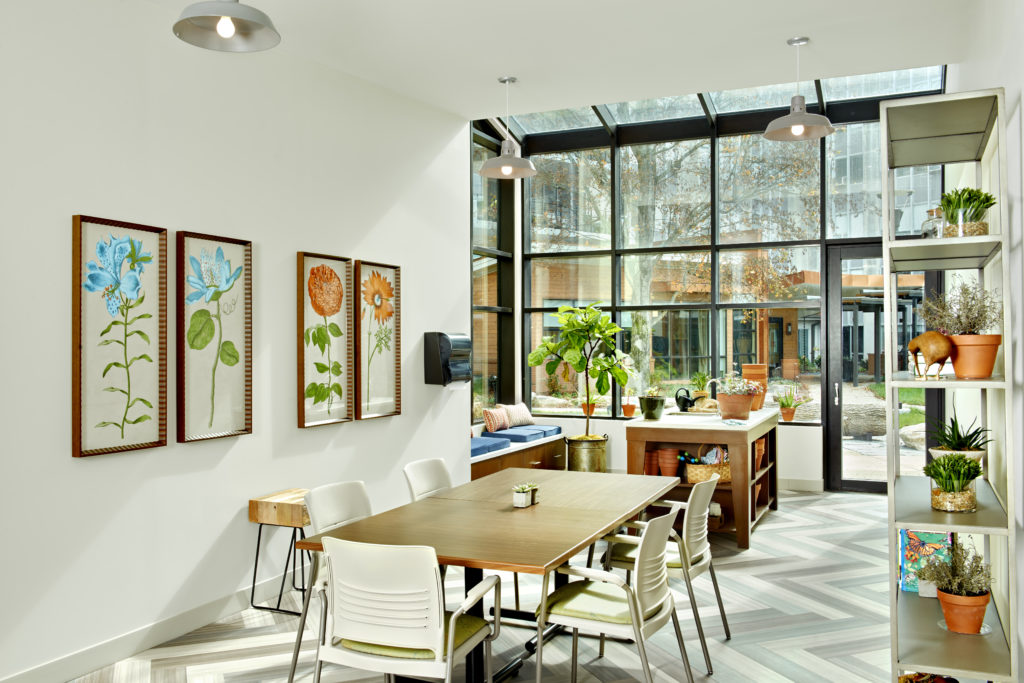As baby boomers steadily creep up in age, the number of older adults requiring memory care is expected to balloon as well. Though this may come as welcome news to memory care communities nationwide, most of them aren’t necessarily up to the task of properly taking care of boomers, according to some experts.
There are many factors that should be taken into account when adapting and designing memory care communities for the incoming baby boomers, including a focus on person-centered care, a connection to nature and wayfinding design, Joseph Hassel, principal at Perkins Eastman, said during a webinar hosted by the firm on Monday.
Person-centered care
Putting the residents’ needs first, as opposed to viewing residents as passive receivers of treatment, should act as a foundation for senior living communities—especially when memory care is involved, Abe’s Garden (pictured above) CEO Andrew Sandler said during the webinar. Abe’s Garden is a stand-alone memory care community in Nashville, Tennessee.
“We have to look objectively at our communities and ask how can we give our residents are much control as possible? It is a very difficult because we live in a regulatory environment, but it is something we have to question,” he said.
One amenity that Abe’s Garden wove into the community is flexible dining. Something as simple as letting residents eat when they’re hungry makes a whole lot of difference for residents who are usually forced to eat at specific times, as if in a hospital setting.
Another way to implement person-centered care is to adapt a Montessori approach, Jennifer McDermott, associate principal at Perkins Eastman, said.
The Montessori method is usually described as a type of child-centered educational approach, but in a senior living context it focuses on the aspect of the method that allows its users to move freely around to different activities. The method also puts an emphasis on independence and freedom within limits.
“Giving residents the option of flexible schedules with a Montessori approach can help get residents involved in a passive way,” she said.
Having impromptu activities around the community, like dance classes, art classes, culinary actives and gardening, which residents can take part in when they choose, will help leave fewer patients out of socializing.
Feeling a sense of connection to the outdoors is also extremely important for memory care residents, McDermott added.
“The outdoors is important for stress reduction and aids in sundowning,” she said. “It also opens up so many options for outdoor activities, like outdoor dining or gardening for farm-to-table dining.”
Minimize confusion
In addition to implementing a person-centered care plan, it is especially important in memory care communities to do everything possible to reduce the amount of potential confusion that could come from the design of a community. Thinking about wayfinding when designing communities can play a large role in residents’ well being.
To minimize confusion, Hassel recommended reducing the number of flooring materials in a community, using one carpet throughout all the neighborhoods and corridors, providing clear signage throughout the community and including “active landmarks.”
“Active landmarks help residents know where they are—something as simple as a grandfather clock in an entryway,” he said. “We have even been experimenting with an iPad framed and mounted on a wall that the community can program to be utilized as signage or as an interactive device for residents and their family members.”
Another design element that can help keep residents from getting confused is a direct line of sight from the bed to the bathroom, Hassel said. In multi-household memory care communities, building each household open to the other can help memory care patients from losing track of where they are, Hassel added.
“Historically, skilled care environments weren’t able to meet those impacted by cognitive impairments purely because they weren’t designed for that purpose,” he said. “But if designed properly they can be successful for the residents and providers.”
Written by Alana Stramowski


